Sharing the history, growth, and ministry of Peachtree Road UMC… one story at a time.
A LEGACY PROJECT OF PEACTHREE ROAD
404.266.2373
[email protected]
prumc.org

How do you tell a 100-year-old story?
When I look around at our church, Peachtree Road United Methodist Church has come a long way from being a dream in the hearts of a few faithful saints. And I cannot help but wonder what those saints would say in the early years if God had whispered to their hearts, “You will grow and become strong. You will take risks for generations to come. You will be a light on Peachtree Street. I will bless you with beautiful land and buildings beyond your imagination. You will grow and spread your wings for meeting the needs of Atlanta and the world. You are my people, and I will bless you.”
We are those people and we have been blessed. Looking back over history, those promises that inspired and fed a young church are still blessing us and leading us forward. But to fully recognize the fulfillment of so many promises, we must look back, study the past, learn and continue to grow.
Let’s begin.

The Lord is honored…. He will be the sure foundation for your times.
Isaiah 33:5-6
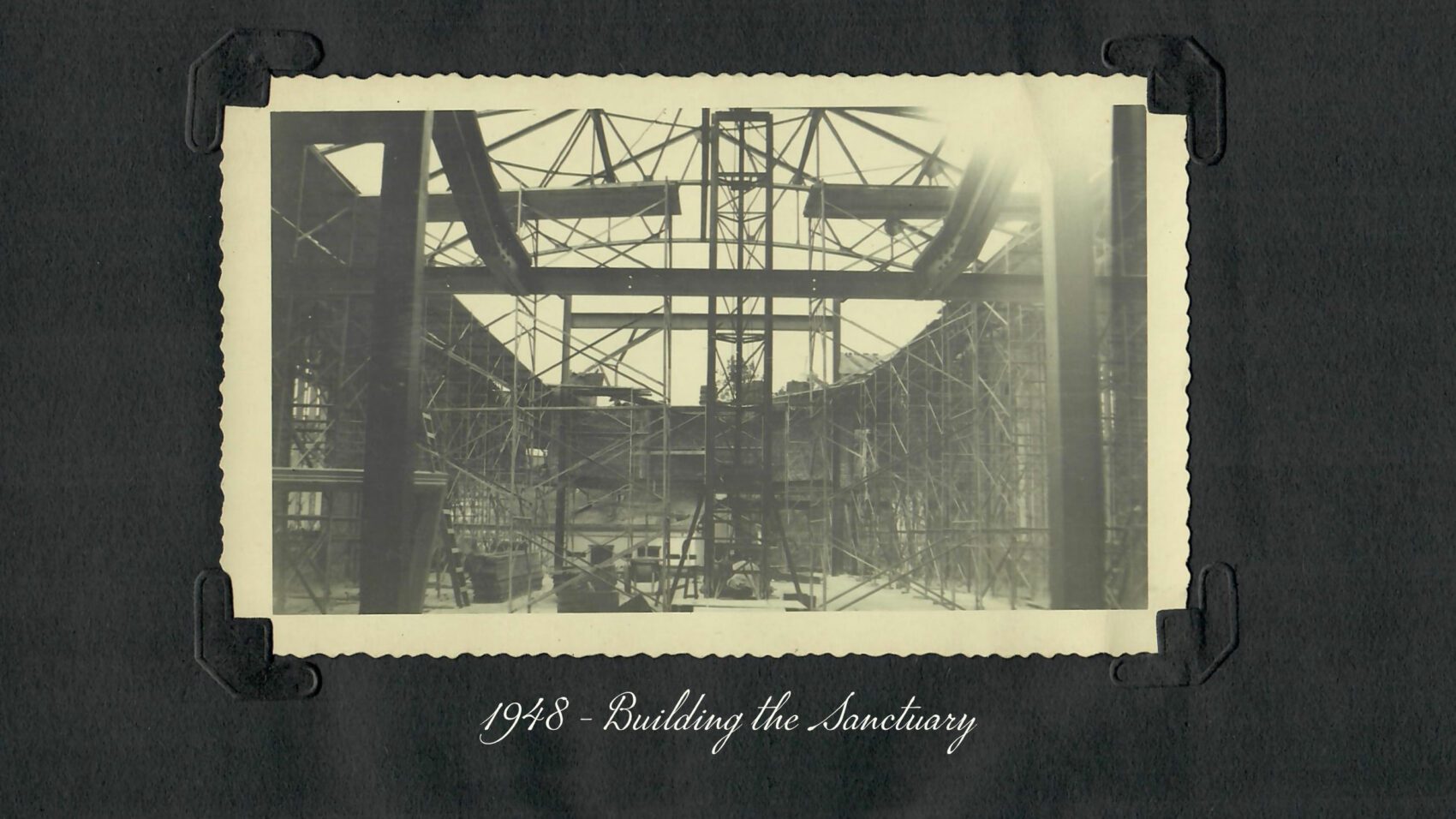
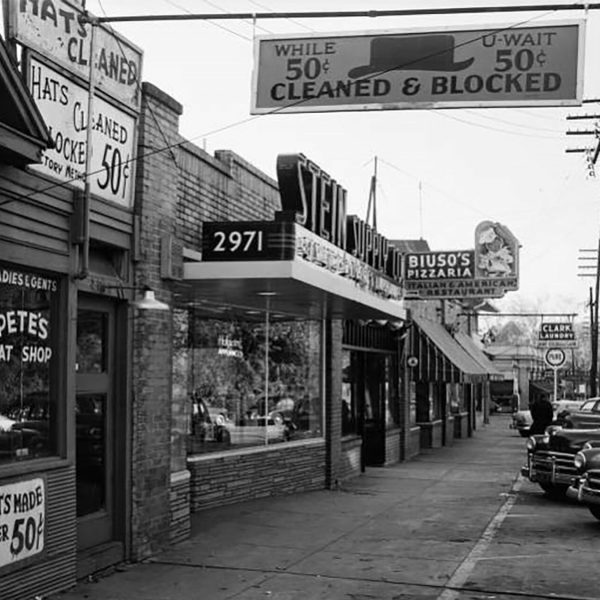
The year was 1925. Atlanta was a growing city. Rising from the ashes of the Civil War just 60 years prior, transportation was moving Atlanta forward. Hartsfield Airport was new. The railroads, trolleys, and automobiles were moving people from the center of the city to the suburbs. Buckhead was transitioning from being a place “out in the sticks” where wealthier families had summer homes to more and more year-round living in neighborhoods like Garden Hills and Peachtree Heights Park.
Retired Methodist minister–Rev. E. H. Wood–had been faithfully praying for a church in the growing community. As he shared his passionate desire, other like-minded people began to catch his vision and soon a dream would become a reality.
In January of 1925 a survey of households encompassing a one-mile radius from the business center of Buckhead was completed by Reverend J.C. Adams from the North Georgia Conference, along with Buckhead resident Mr. C. J. Cofer and 19 divinity students from Emory University. While we don’t know how many surveys were completed, we do know there was a tremendous response and Methodists were discovered all through the Buckhead area.
Fueled by these encouraging findings, these faithful leaders forged ahead.
Dr. and Mrs. M. T. Salter–who lived at 3221 Peachtree Road–opened their home on April 28, 1925, to host this organizational meeting under the leadership of Dr. Pierce and Rev. Wood. It was during this meeting that the church was given the name Peachtree Road Methodist Church; Rev. Wood would be the first pastor.
Rev. Adams, Mr. Cofer and Rev. Wood consulted with Dr. W. L. Pierce, Presiding Elder of the Atlanta District, who gave his blessing upon their vision and encouraged them to proceed with an organizational meeting.
At the organizational meeting, nineteen people placed their membership in this new church, and by the end of the first year there would be 88 names on the charter roll.
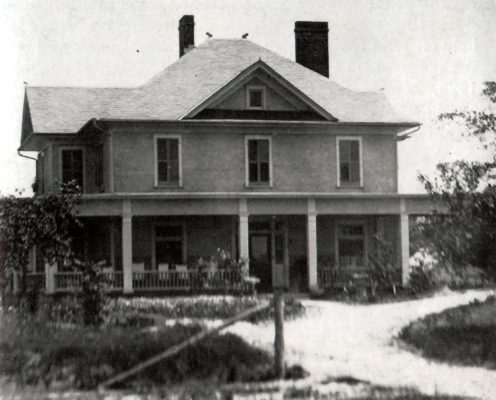
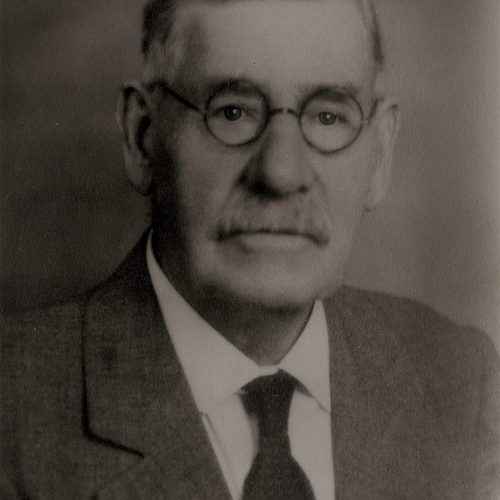
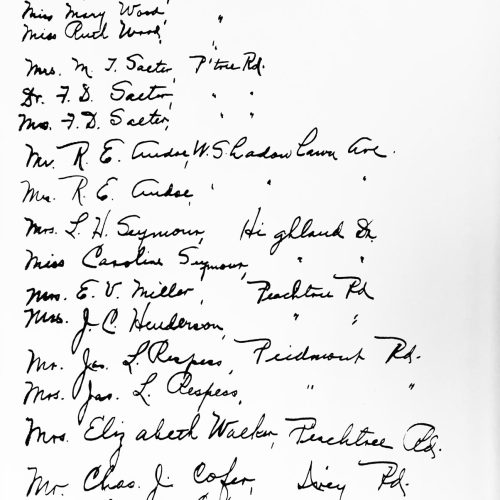
During May there were five meetings in the Salter home and other interested Methodists joined these initial meetings. At the meeting on May 5, 1925, the purchase of land was proposed. Property at the present-day corner of Peachtree and Sardis Way, 3122 Peachtree Road, was on the market for $15,000. The church had little money but was able to purchase the land through generous loans of individuals.
A temporary, wooden chapel would soon be built on this parcel of land. G.W. Cooley was put in charge of buying lumber and building the chapel. By the first week of June, the chapel was partially completed with a roof and floor, but no walls. It was called a tabernacle.

The first tabernacle

The first church school building

Church school and sanctuary
The earliest memories I have are of the little, white clapboard church down in the middle of Buckhead, where the IHOP is now.
Margaret mulligan

The first parsonage
On June 7, 1925 the newly-organized church held their first worship service in the tabernacle. Not only was this the date of the first worship service, but the first Sunday School classes were taught, organized by Mrs. C. J. Cofer, with 45 people attending. Sunday School would be a vital part of church life as the membership grew.
Within the first year, however, the young church fell into financial difficulty. The church had been led to believe they would receive financial support from the North Georgia Conference, but in the end, it was Emory University that stepped in to help. Over the next few years with careful financial planning, the church was able to purchase their first parsonage at the corner of Peachtree and Sardis for $6000.
In time the church founders erected additional temporary structures. By 1941 the church was debt-free. With the encouragement and financial support of Emory, the young church was gaining stability and community participation.
Not only was Sunday School a vital part of the church growth, but music was also important from the very beginning. From April through September 1925, Mrs. C. J. Cofer played the piano at all services. In October of the same year, Miss Leona Wood and Mrs. C.H. Wetmore were named pianists. In December Miss Wood was appointed Choir Director and continued in that role for 25 years. According to a longtime choir member Margaret Mulligan, during the 30s Miss Wood talked to the Board of Stewards and convinced them to hire a soloist for each voice part of the choir because she wanted to be able to do more classical anthems for the church. It was an amazing step for such a small church to have paid staff singers in the 1930s!
We loved living next door to the church, because people coming there would just drop by the house. The members were so warm and welcoming. We loved having people come over, even if it was just for a few minutes.
To allow room for continued church growth additional lots were purchased for $7000, completing the square of land at Peachtree and Sardis Way. This parcel gave the church 150 feet of frontage on Peachtree Road, 125 feet on Roswell Road, and the entire length of Sardis Way– a valuable piece of real estate. The church sold the acquired property for $41,500 and purchased new land (our present site) at 3180 Peachtree for $17,940. A second parsonage would soon be acquired at a cost of $11,000: 257 Rumson Road.
The original tabernacle and other small buildings were moved up Peachtree to the new address.
Living Our Roots
by Kelly Brannon
Today’s music program is blessed with the church’s continued commitment to our Chancel Choir. Often vocalists by vocation, eight professional singers (two per voice part) with a passion for excellence in worship join the ranks of our choir loft each Sunday. They periodically share solos and always elevate the music offered in our worship services here at Peachtree Road. We are richly blessed by the gift of their talents.

In 1941 James L. Respess, Sr. chaired the committee that would oversee the construction of The Great Hall, completed in 1942 at the cost of $35,000. This was an exciting time of growth, and the multi-functional building was used for all services of public worship as well as banquets, pageants, mid-week services and even all types of recreation.
On Thursday, June 4, 1942, a memorable “first” supper was held in the Great Hall. The pastor and the people, eager to use their new dining room facilities, planned a dinner before all the equipment was fully installed. However, the gas ranges would not heat because they had not been installed correctly, and it was difficult to broil chicken without a hot range! 370 people had come for supper and instead of eating at the announced hour of 6:30 pm, the meal was finally served 3 hours later. But no one seemed to mind as it was a great time for renewing acquaintances with old friends and enjoying fellowship together. Nobody ever forgot it!
During 1942, from mid-September through the end of May, supper was served in the Great Hall on Wednesday nights at 6:30. Sixteen hostesses from the Women’s Society of Christian Service presided at tables for 10. After supper a program was presented by speakers from other churches, universities, or civic organizations, with regular attendance of 150-300 people.
To encourage youth outreach and participation on the church campus, Boy Scout Troop No. 59 was organized on December 7, 1942. In 1944 Cub Scout as well as Girl Scout troops were organized. To accommodate these active groups a two-story scout building was built in 1943, and a second scout hut built in 1946. Additional land–a wooded lot to the rear of the church–would be purchased in 1947 by individuals for future expansion of the youth recreation program.
The number and frequency of programs and activities offered by the church was growing, and so was attendance. But the Great Hall was not big enough to house the many functions of this growing congregation. In 1945 the church had 1600 members and debt-free property valued at $130,000. It would soon be time to build again.
Did you know?
Through all the years of growth and expansion, a portion of The Great Hall is used to this day, now known as Heritage Hall. It is fascinating to think that Heritage Hall has been with us for all these years and used for everything from ping pong to Sunday School classes, from parties to pageants to mid-week prayer services.

The Girl Scout Hut

The Boy Scout Hut
Did you know?
Mrs. R.E. Stewart, hostess for the Great Hall, recorded serving 13, 860 meals to 127 groups during the year from Sept 1951 until August 1952.
There is romance in building a bridge, a factory... a school, anything which develops community... But the romance of building a church is greater still.
Nat long

The first floor of the Church Building
The Board of Stewards met in August of 1945 and voted unanimously in favor of proceeding with a $200,000 building campaign over five years that would add a sanctuary and a Church School building. Clyde Kennedy, Jr. chaired this building effort.
According to a letter sent to the congregation on August 19, 1947, from the building committee, construction was slow because of the shortage of building materials following the war and the lack of sufficient cash with which to begin. However, the church was able to build the lower floor of the church sanctuary at a cost of $45,000. The lower floor was used for the Children’s Division of the Church School.
After revisions of architecture plans, the building committee was ready to submit plans for the Church School Building and the Sanctuary with the hopes of construction beginning by March 1, 1948. The groundbreaking ceremony took place on April 21, 1948. One year later, on Palm Sunday, April 19, 1949, the beautiful white colonial-style church, and Church School Building opened for services. Dr. Nat Long officiated. What a day of celebration and praise!
It was a day of celebration when the new sanctuary opened. People were flocking to the church from all directions. Even the workmen who had helped build the church school building and sanctuary were in attendance and asked to stand in recognition of their contribution to the project.
“The church didn’t look like much because it did not have a top on it. It was all flat with a gravel driveway all the way around it. So you didn’t dare come to church late or leave early because everyone would hear the gravel crunching and see the dust flying. I will never forget that!”
Carolyn Dvorscak
“Because of gas rationing during the Second World War, my parents were encouraged to visit the growing Peachtree Road. I received my third grade Bible from Nat Long, Sr. in the fall of 1943. That was 80 years ago! And I can still say the most consistent thing in my life has been belonging to the family of Peachtree Road United Methodist Church.”
Nancy Thompson Toon
It was late March in 1949. Peachtree Road United Methodist Church was about to install a steeple with a lighted cross, the crowning glory on the newly constructed sanctuary.
Sharing the history, growth, and ministry of Peachtree Road UMC… one story at a time.

A LEGACY PROJECT OF PEACTHREE ROAD
404.266.2373
[email protected]
prumc.org